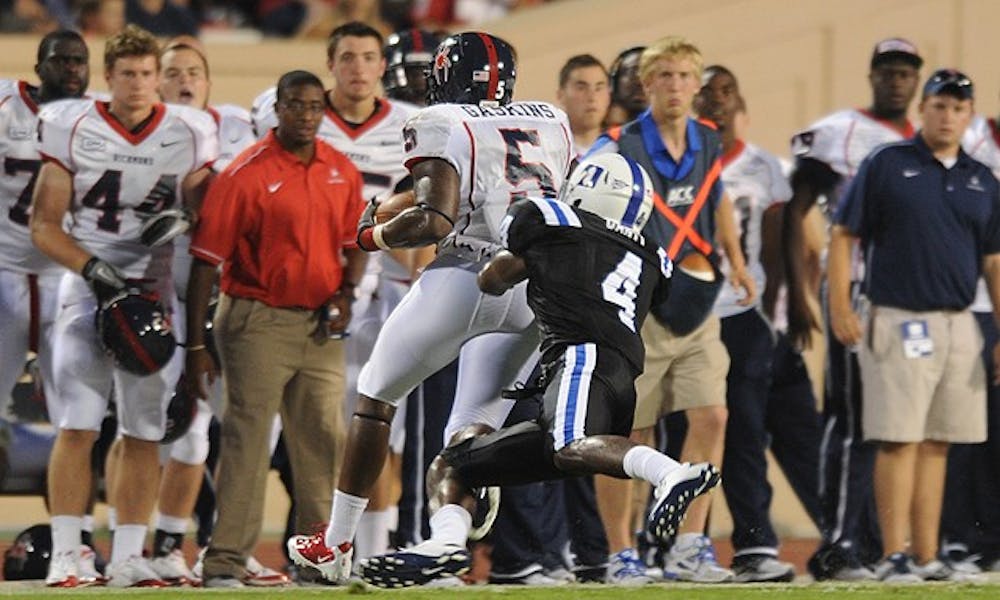Even before the first week of the season, Duke was going to be a double-digit underdog against Stanford. After the Blue Devils fell flat in their opener against an FCS opponent and the Cardinal cruised to an easy 57-3 victory in its first game, most analysts are predicting a blowout.
No. 6 Stanford (1-0), which capped off an 11-1 regular season with a dominant 40-12 win over ACC champion Virginia Tech in the Orange Bowl last year, lost head coach Jim Harbaugh to the NFL in the offseason. The Cardinal, however, returned quarterback Andrew Luck, who was runner-up for the Heisman trophy last year and is the favorite to win it this time around.
“[Luck] is some kind of physical specimen,” Duke head coach David Cutcliffe said. “He’s a big, strong athlete. He’s got great feet, great quick hands, and he has an uncanny sense of poise and ability to buy a little time.”
Though Luck has pro scouts salivating over his potential, Stanford is far from a one-man team. Luck’s ability and reputation often leads teams to focus heavily on the pass, exposing them to the Cardinal’s bruising rushing attack. Last year Stanford running back Stepfan Taylor racked up more than 1,100 yards and 15 touchdowns, more than all of Duke’s running backs combined. Taylor started his season last week with two touchdowns against San Jose State.
“They’re just physical,” Cutcliffe said of Stanford’s offense. “They’re going to line up in two and three tight end sets and just do a lot of shifts and motion to try and create support problems for you… [Taylor] runs downhill… I like watching him run when I’m not getting ready to have to play him.”
To stop Luck and the rest of the Stanford offense, which scored 40.3 points per game last season, Duke will have to generate more backfield pressure than it did against Richmond, when the defense failed to come up with a sack. On the whole, the defense played fairly well against the Spiders, allowing only 13 points on possessions starting outside the Blue Devil 30-yard line. Still, miscommunications on several crucial third down attempts kept the Duke offense on the sideline.
But for the most part, the burden of maintaining possession rests with the offense, which lost two fumbles and generated only 5.9 yards per attempt through the air. While the ground game showed signs of improvement, it will be crucial for the offense to click in all phases of the game if the Blue Devils are to keep their opponents’ offense, and the pressure the Cardinal can bring, off the field.
Against an opponent like Stanford, offense might be the best defense.
“I love to keep the football even if we’re not playing a potent offense,” Cutcliffe said. “I learned this when I was a kid in the backyard. As long as we have the ball you can’t score if we take care of it…. Possession is a key thing.”
But keeping the ball out of Luck’s hands is easier said than done. The Cardinal’s defense, much like its running game, is often overlooked. Last year Stanford allowed 20 points or more in only four of its 13 games, and in one instance—against Wake Forest—the opponent only crossed the 20-point barrier long after the outcome had been decided.
The Cardinal’s defensive success stems from its ability to generate turnovers. The team finished seventh nationally in turnover margin last year. While Stanford’s defense may not be as athletic as some of the nation’s other elite defenses, Cutcliffe sees the defense as well coached and aggressive.
“Stanford’s got great technique,” Duke center Dave Harding said. “They’re just really high energy guys who expect to win. They’ll do whatever it takes—fight, scratch—they’re a really strong-willed team.”
The Cardinal hasn’t lost to an underdog since a November 2009 game against California, so Duke has plenty of work to do to create an upset. But a win, even a close game, would be an incredible step forward for the program.
Get The Chronicle straight to your inbox
Signup for our weekly newsletter. Cancel at any time.

